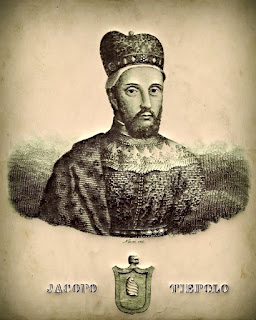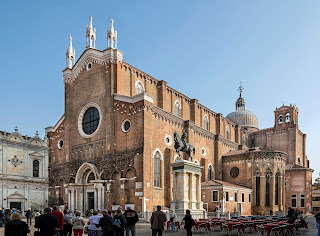Virtuoso performer was prolific composer
 |
| Francesco Maria Veracini was one of the 18th century's leading violinists |
He was to become famous throughout Europe for his
performances and for a while he was Handel’s biggest rival as a composer.
Veracini was born into a musical family, although his father
was a pharmacist and undertaker. His grandfather, Francesco, had been one of the first
violinists in Florence and had a music school business, which he eventually
passed on to his son, Antonio, who was Francesco’s teacher. Veracini grew up in
Florence but by 1711 he had established himself in Venice where he played in
church orchestras.
In 1712 on February 1, his 22nd birthday, he performed a
violin concerto of his own composition in the church of Santa Maria Gloriosa dei Frari in
honour of the visit to Venice of the Austrian ambassador. This is the first recorded
public performance by Veracini playing one of his own compositions. At about
that time, one of his performances so impressed the violinist, Giuseppe
Tartini, that he decided to take time off to study better use of the bow in
Ancona.
The violinist Pietro Locatelli is thought to have studied
with Veracini at this time.
Veracini performed in London in 1714 and then went to
Germany, where he obtained a court position in Dresden at an impressive salary.
 |
| Via Palazzuolo in Florence, where Veracini was born |
He survived the incident but rumours of his madness were
circulated subsequently. He seemingly lived something of a charmed life, some years later escaping a shipwreck in which his two treasured Stainer violins - which he called St Peter and St Paul - were lost.
Veracini returned to London in 1733 and performed in many
different theatres. His operas were produced at the Opera of the Nobility, who hired the great castrato opera singer, Farinelli, and were the main rivals to Handel’s theatre.
He went back to Italy for good in 1750 and continued to
compose, conduct and play the violin until he was well into his 70s. He was appointed maestro di cappella for the
churches of San Pancrazio and San Gaetano in Florence. Although he composed
music for operas, he is perhaps best known for his violin sonatas. Veracini
died in Florence in 1768.
There is a plaque commemorating Veracini at the house where
he was born at number 30 Via Palazzuolo in Florence in the parish of San
Salvatore, a few minutes from the city centre. Nearby is the church of San Salvatore di Ognissanti, known simply as
Chiesa di Ognissanti, which is located in a piazza of the same name.
 |
| The Frari church in Venice, where Veracini gave his first public performance of one of his own compositions |
The church of Santa Maria Gloriosa dei Frari in Venice,
where Veracini first played one of his own compositions, is a huge, plain
Gothic church in Campo dei Frari in San Polo and is known simply to Venetians
as the Frari. The church houses the tombs of Monteverdi, Rossini, and Titian
and has works of art by Titian, Bellini, Sansovino and Donatello. The church is
open daily from 9.00am to 5.30pm and on Sundays from 1.00 to 5.30pm.
More reading:
Farinelli, the castrato who became music's first superstar
How Pietro Locatelli's playing left listeners astonished
The brilliance of Andrea Zani, 18th century violinist and composer
Also on this day:
1891: The birth of Corradino d'Ascanio, designer of the Vespa scooter
1922: The birth of opera singer Renata Tebaldi
(Picture credits: Via Palazzuolo and plaque by Sailko)
More reading:
Farinelli, the castrato who became music's first superstar
How Pietro Locatelli's playing left listeners astonished
The brilliance of Andrea Zani, 18th century violinist and composer
Also on this day:
1891: The birth of Corradino d'Ascanio, designer of the Vespa scooter
1922: The birth of opera singer Renata Tebaldi
(Picture credits: Via Palazzuolo and plaque by Sailko)




